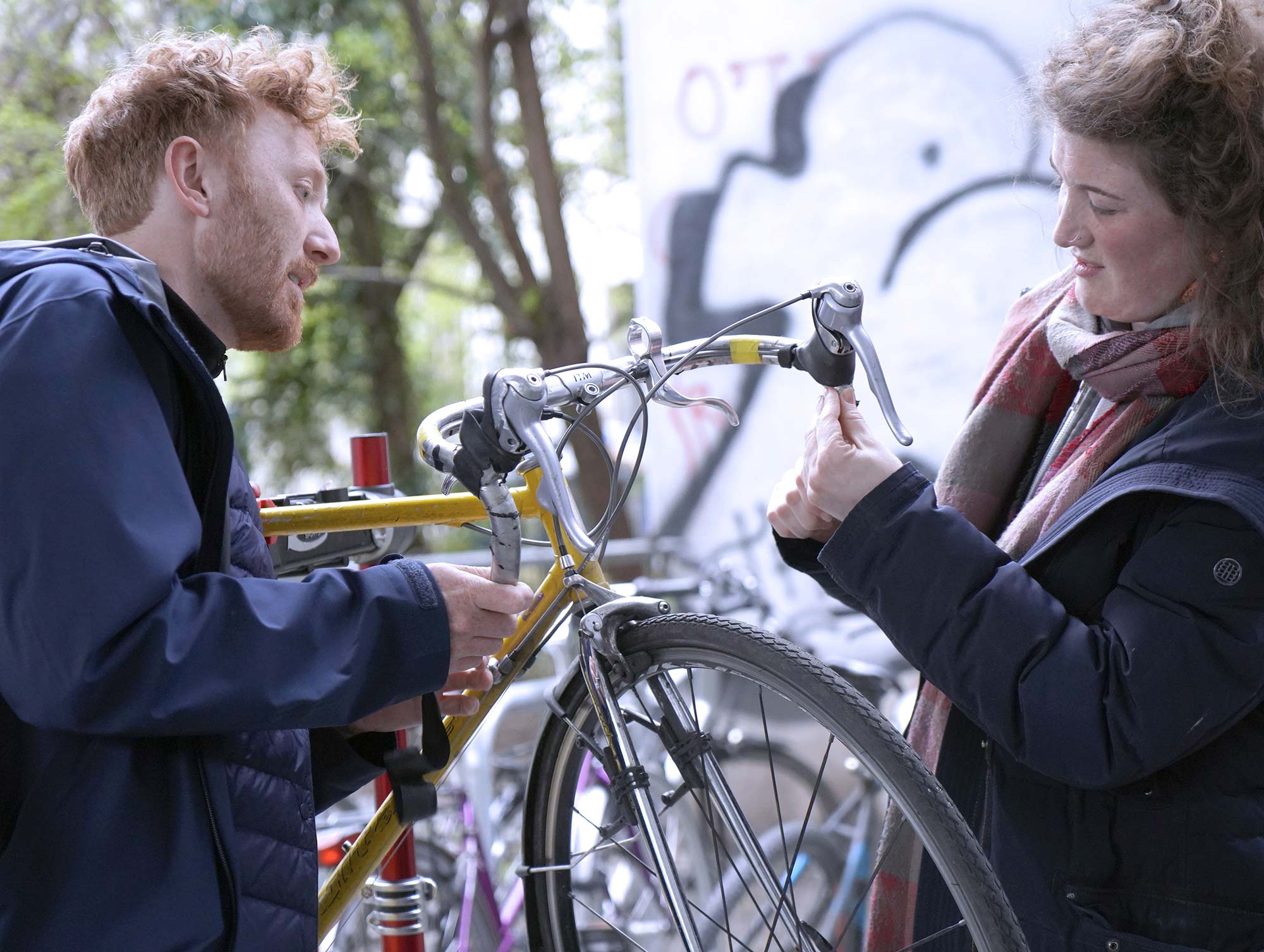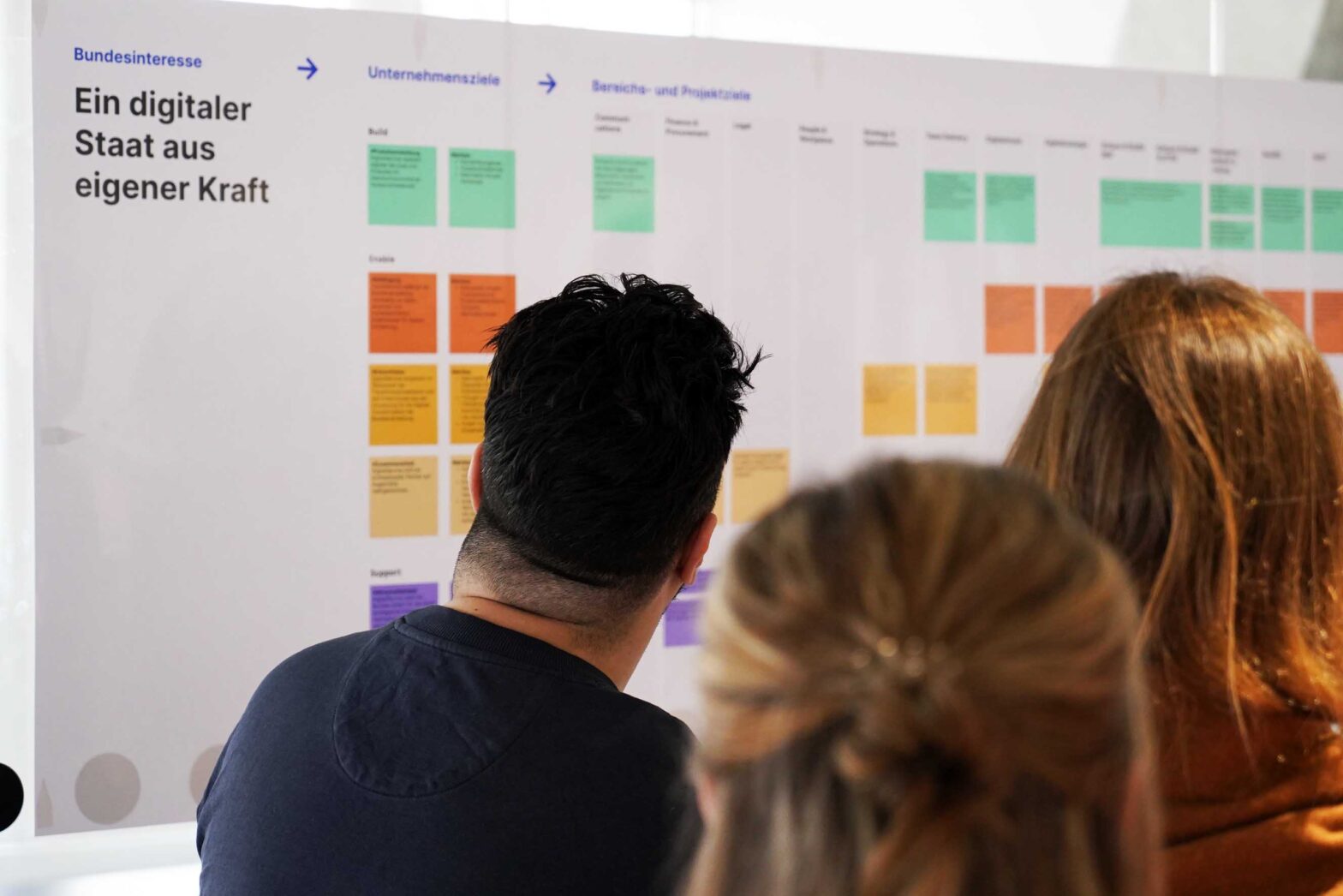Week 100 feels like a significant number and a proper milestone. Racing towards the 2-year mark, I want to start writing notes for a more thorough reflective piece. That’s one I might even have to write in German.
My colleague Bene, who also writes and publishes weeknotes, invited me to a reflection session in early April. He joined the organisation as a product manager the same day as me. Spending lunchtime conversing and exchanging observations will help us both articulate what we have experienced since arriving in May 2022. It should also help us adjust and refine future focus topics.
Somewhat unrelated yet linked, Bene walked me through some observations he and his team recently made about the effective implementation of the Service Standard. Talking and sketching on the whiteboard, we noted the number of intermediaries and consequent handovers that lead to worse-than-expected outcomes in digitalisation efforts. It also became apparent where the digital check with its principles for digital-ready legislation can have an effect and on what level the Service Standard needs to exert.

I cleaned up the sketch I carried out of our exchange and will spend more time thinking about the implications in the coming days. This should guide our engagement focus going forward.
Looking at strategy together
One of the last few things I did before launching into the long Easter weekend was participating in a deep-dive session on organisational goals and team contributions.
Our strategy team put up a poster a few days ago after the offsite that I missed by a day at the end of my holidays. It summarises the organisation’s overarching goal from a federal government-level view. It derives goals for the organisation as well as projects and units. It’s tangible enough to give direction and guidance but high-level enough to allow teams to define their related objectives and targets.
CEO Christina and CSO Magdalena, representing our executive leadership team, invited those interested in an exchange for a kitchen chat. Some 20 to 30 people joined, mostly in person and some remotely. There was a context setting before giving reading time to start everyone off. Good questions kept coming. Besides me, the head of product management, Clara, and the head of people, Anna-Lisa, joined the exchange. We discussed what good universal metrics are, how much our value proposition can last and how we deal with other actors using the same terms – like agile and user-centred – without doing it or offering proof. This conversation is likely to continue in the coming weeks.
Appreciating our organisational culture
There is plenty I value about Digital Service.
This pre-Easter week was special as school break had begun. Suddenly, we had kids sitting in planning meetings, making crayon drawings and listening to audiobooks. Other older kids roamed the office with parents helping out in practical ways.
The very avid cyclists at Digital Service offered a spring bike repair session on Tuesday afternoon. With care and dedication, they checked air pressure, changed the handlebar tape, and de-rusted chains after the wet winter.

Activities and experiences like those make our organisation feel different. I have worked in companies of a similar size, around 150 people, and such activities aren’t a given. ‘Genuinely caring’ is how I would describe it, and I hope that’s a spirit we can retain for a long time.
On Thursday morning, our people team shared an updated salary band for the entire organisation, following a review of similar roles across industries, including the German public sector. With it, we published new levels and level descriptions for all disciplines, including design and user research. Instead of dropping them in the intranet top-down, people managers had fed into the drafts over the last few weeks to improve and refine them.
Having skipped a couple of accessibility onboarding sessions, I could co-deliver one again since we put some healthy rota in place. I always enjoy talking to new starters about the topic during their first few days. One participant messaged me afterwards, saying: “I thought the session was AMAZING – thank you so much!”
Plotting the next few months
The conference season has clearly started. I have received invitations to some events and submitted proposals to others.
The Federal Ministry for Family Affairs, Senior Citizens, Women, and Youth’s Innovation Office invited me to join their ‘Digital Morning’ format to discuss the role of design in the digital transformation of the public sector. That seems like something I can do.
Following a conversation some weeks ago in Magdeburg, I received a formal invitation from the Minister for Infrastructure and Digital of the state Sachsen-Anhalt to join their Digital Council. The council was set up in 2022 to advise on the state’s digital agenda and strategy.
My former boss at Digital Service, Philipp, served on it until last summer when he left the organisation. He suggested I take over the baton, which I am glad to do. Since leaving Sachsen-Anhalt and its state capital, Magdeburg, over 20 years ago, I have spent limited time there. I’ve interacted with public services there sparingly since then. My passport renewal experience two summers ago was somewhat analogue and rocky. I am looking forward to joining the first of a string of council sessions in mid-April.
I proactively submitted a proposal for CityLAB Berlin’s summer conference. Charlotte and I spoke there in the summer of 2022. Since then, our team has done some good work, and it might be worth returning with some stories. Having already purchased a ticket for the ‘Service Design in Government’ conference in Edinburgh anyway and having spoken there for the past 2 years, I skipped a submission this year. My colleagues Lena and Sabrina prepared one, though, following their recent virtual contribution.
At the end of the week, Kara and I spoke with our dear Finnish colleague Anni, who’s been building the service design team in the City of Helsinki for the past 5 years. Anni is heading up Julkis-muotoilijat, a “community of practice for designers and design-minded civil servants working in Finnish state, regional and municipal government”. As we already announced in our January international community blog post, we will co-run an event in Helsinki at the beginning of October. Now, we have initiated planning mode and will see how much support we can offer to their efforts.
In the coming 3 weeks, colleagues and I will meet with some public sector accessibility folks from and in Berlin. I am looking forward to those encounters and the related learning opportunities.
What’s next
In the coming days and weeks, I need to carry some blog posts over the finishing line. There is one on linking the digital check for digital-ready legislation with the Service Standard. The second covers what user researchers do at Digital Service and how their work supports teams. The third on the shortlist covers our accessibility activities over the past 2 years. With a clear target for blog posts, I want to see these all out in the new quarter.
Welcoming the record number of four new starters in our discipline in April, I am putting together a new ‘Hello!’ deck to cover everything I want them to hear and know. The onboarding experience matters so much, and only at Digital Service does it seem like it’s more carefully designed. Neither at Nokia nor GDS was it nearly as thoughtfully considered as here. It sets the tone and influences how someone feels and can orientate themselves. Our Diversity, Equity and Inclusion (DEI) working group started looking into the onboarding experience, too. I hope to hear from them how we can improve and iterate it further.
Following some interviews with design candidates this week, I will continue next week. We can only interview a limited number of people out of the 218 applicants. Having mentioned that number in a staffing meeting, I was met with astonishment and disbelief by colleagues. Some strong candidates were among the people I’ve talked to so far, and I am sure we’ll find some great additions for the team.

